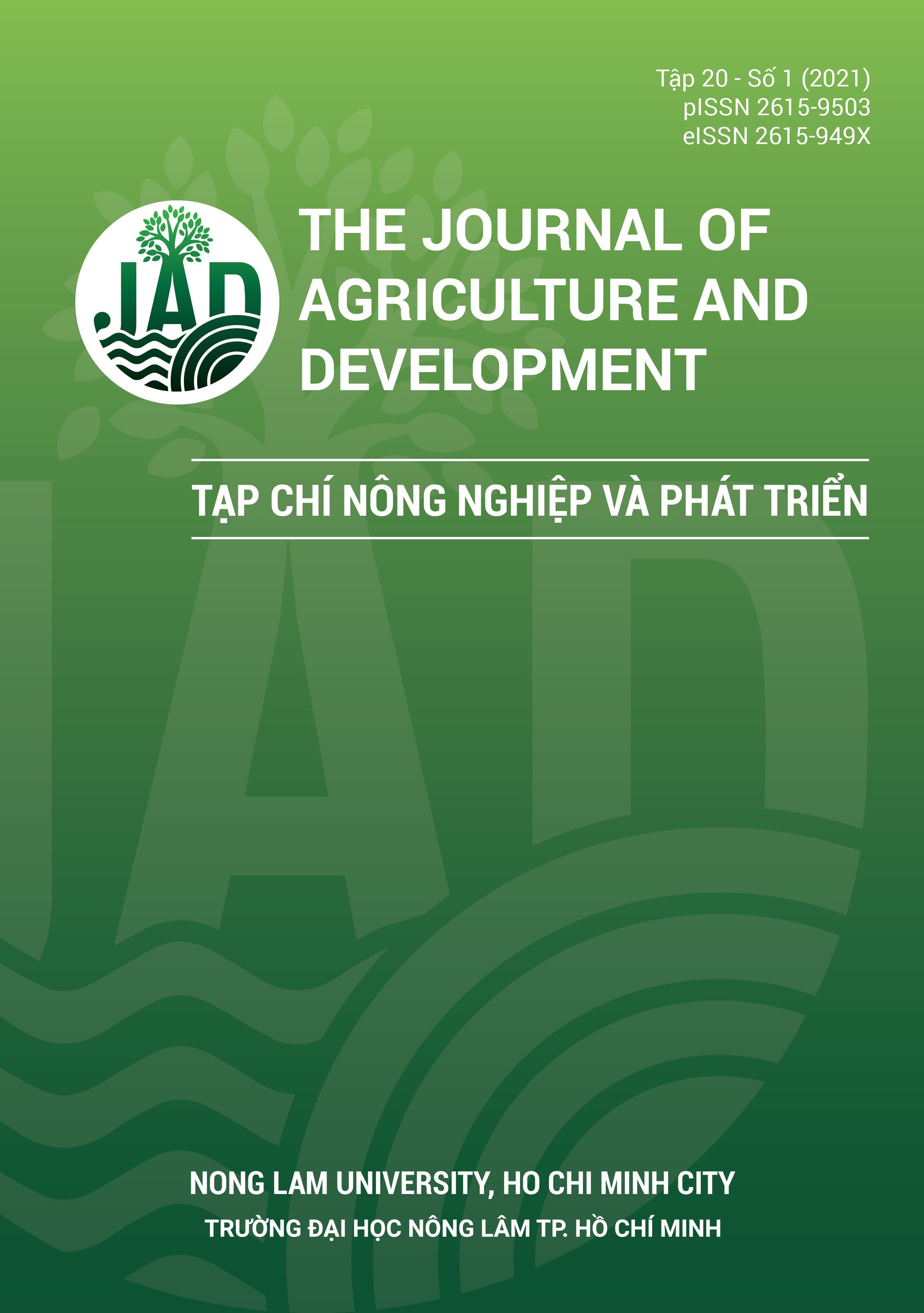Hiệu quả của fluralaner cung cấp qua đường uống trong việc kiểm soát mạt và cải thiện phúc lợi ở gà đẻ
Main Article Content
Tóm tắt
Mục tiêu của đề tài là nhằm đánh giá hiệu quả diệt mạt của sản phẩm Exzolt (thành phần chính là fluralaner) và đồng thời giúp cải thiện phúc lợi trên gà mái đẻ. Tiến hành theo dõi và ghi nhận các chỉ tiêu về năng suất chăn nuôi, đánh giá mức độ nhiễm mạt, số lượng trứng có chấm đỏ, các biểu hiện về tập tính của gà mái trước và sau khi sử dụng thuốc Exzolt bằng việc quan sát qua camera. Kết quả cho thấy trại khảo sát nhiễm mạt rất nặng với mức độ nhiễm trung bình là 1,79 trên thang điểm 0 - 2. Sau liệu trình điều trị mạt bằng thuốc Exzolt, trại khảo sát đã không còn sự hiện diện của mạt trên gà mái đẻ, đồng thời hiệu quả của thuốc được tiếp tục duy trì và kéo dài nhiều tuần sau đó. Việc sử dụng thuốc diệt mạt Exzolt không ảnh hưởng đến lượng thức ăn ăn vào hằng ngày và tỷ lệ gà chết và loại thải. Tỷ lệ trứng có chấm đỏ giảm rõ rệt. Đặc biệt, các chỉ tiêu về tập tính gây khó chịu cho gà mái đẻ đều giảm xuống rõ rệt so với lúc chưa sử dụng thuốc diệt mạt. Đây là lý do khuyến cáo sử dụng sản phẩm này trong việc kiểm soát mạt trên gà đẻ.
Article Details
Tài liệu tham khảo
Abdigoudarzi, M., Mirafzali, M. S., & Belgheiszadeh, H. (2013). Human infestation with Dermanyssus gallinae (Acari: Dermanyssidae) in a family referred with pruritus and skin lesions. Journal of Arthropod Borne Diseases 8(1), 119-123.
Chauve, C. (1998). The poultry red mite Dermanyssus gallinae (De Geer, 1778): Current situation andfuture prospective for control. Veterinary Parasitology 79(3), 239-245. https://doi.org/10.1016/S0304-4017(98)00167-8
George, D. R., Finn, R. D., Graham, K. M., Mul, M. F., Maurer, V., Moro, C. V., & Sparagano, O. A. E. (2015). Should the poultry red mite Dermanyssus gallinae be of wider concern for veterinary and medical science? Parasites & Vectors 8, 178. https://doi.org/10.1186/s13071-015-0768-7
Hinkle, N. C., Jirjis, F., Szewczyk, E., Sun, F., & Flochlay-Sigognault, A. (2018). Efficacy and safety assessment of a water-soluble formulation of fluralaner for treatment of natural Ornithonyssus sylviarum infestations in laying hens. Parasites & Vectors 11, 99. https://doi.org/10.1186/s13071-018-2678-y
Lima-Barbero, J. F., Villar, M., Hofle, U., & de la Fuente, J. (2020). Challenges for the control of poultry red mite (Dermanyssus gallinae). In Bastidas Pacheco, G. A. (Ed.). Parasitology and Microbiology Research. London, UK: IntechOpen. https://doi.org/10.5772/intechopen.90439
Mentz, M. B., Silva, G. L., & Silva, C. E. (2015). Dermatitis caused by the tropical fowl mite Ornithonyssus bursa (Berlese) (Acari: Macronyssidae): a case report in humans. Revista da Sociedade Brasileira de Medicina Tropical 48(6), 786-788.
Pham, S. L., Nguyen, B. H., Tran X. H., Nguyen, H. H.,Huynh, T. M. L., Le, N. M., Pham, Q. T., Pham, N.T., Do, N. T., & Nguyen, V. T. (2011). Poultry disease in Vietnam. Ha Noi, Vietnam: Agricultural Publishing House.
Stringham, M., & Watson, W. (2003). Fowl mite management in breeders. The Proceedings of the 2003 Broiler Breeder and Hatchery Management Conference (8). Statesville, North Carolina: North Carolina State University Cooperative Extension Service.
Thomas, E, Temple, D., & Petersen, I. (2019). Effect of fluralaner on behavioural stress indicators in laying hens infested with Dermanyssus gallinae. The 4th International Symposium on Parasite Infections in Poultry (36-37). Vienna, Austria: World Veterinary Poultry Association.
Thomas, E., Zoller, H., Liebisch, G., Alves, L. F. A., Vettorato,. L., Chiummo, R. M., & Sigognault-Flochlay, A. (2018). In vitro activity of fluralaner and commonly used acaricides against Dermanyssus gallinae isolates from Europe and Brazil. Parasites Vectors 11, 361. https://doi.org/10.1186/s13071-018-2956-8








